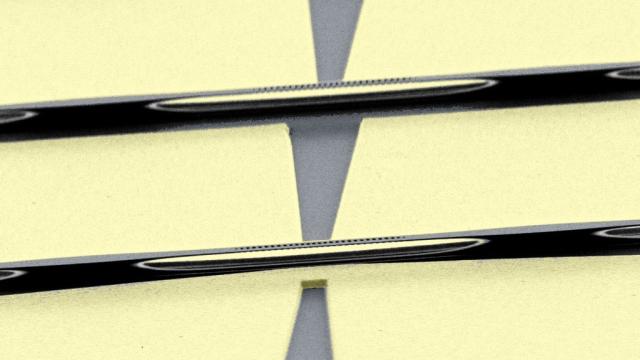A newly created system can enhance quantum communications over longer distances—a small but crucial step toward a quantum internet.
We’re in the early stages of a quantum boom, as researchers are attempting to augment our computing and communications capabilities with systems employing the weird mathematics that govern subatomic particles. One of the core goals of this era are networks that can transmit quantum information over longer scales, which scientists think could lead to advances in cryptography, sensing, or even distributed quantum communication. But these are mainly dreams; such a network cannot truly exist without components like repeaters to extend the distance that quantum information can travel or transducers that can convert quantum information into transmittable photons. This new paper brings the field closer to inventing a quantum repeater.
“Classical repeater stations measure that signal and amplify a copy of it,” Harvard physics graduate student Mihir Bhaskar told Gizmodo. “This is how all information gets across the world. In building a quantum network, we’re trying to do a similar thing, but we’re communicating with single photons.”
Today, our networks send information coded as bits. But certain natural systems, like photons (particles of light) or the electrons orbiting atoms, can store a richer set of information in their properties. More importantly, these systems can entangle, such that repeated measurements at distantly separated points are more correlated than regular probability would otherwise allow. Quantum information scientists think that they can one day use networks employing these attributes to send un-hackable messages, improve the capabilities of sensors, or perform tasks that haven’t even been dreamed up yet.
One of the core challenges of all this is how difficult it is to send quantum information over long distances. This information is coded into single photons, which can be lost over a few kilometers of fibre optic cable. Any network that hopes to connect nodes farther apart than a town would require a repeater to amplify the signal from point A and send it along to point B. However, as an added challenge, and unlike a regular repeater, it’s impossible to recreate an exact copy of a quantum state, since measuring a quantum state destroys it.
A team at Harvard and MIT developed a central node that effectively cuts in half the distance that a message has to travel. The system, held at nearly absolute zero Kelvin inside of a dilution refrigerator, consists of a diamond with a “vacancy” produced by replacing two carbon atoms with a single silicon atom, creating a region that can temporarily store the quantum state fed in by a photon, inside of an ultra-cold dilution refrigerator.
The system receives an incoming photon from point A, then stores the photon’s state (without destroying it) long enough to receive a photon from point B. After synchronizing and entangling enough of these photons, the central node produces a secure key correlated between the two parties, which is only meaningful to the two messengers. They can then use this key to encrypt and decrypt messages between them.
The researchers published their study in the journal Nature.
This is not a repeater that passes along quantum information directly from point A to point B, Bhaskar explained. But it’s a key missing ingredient to eventually get to that point—an intermediate interface between quantum information stored as light and a node in the middle. They’re working on demonstrating that they can send a message from point A to the node and then to point B, or even extending the reach by placing more of these diamond units between two nodes.
There are plenty of other improvements that will be necessary before this device can become a part of long-distance quantum communication. It needs to be implemented between two truly independent parties, not just stations in a lab. Additionally, it currently operates on a different wavelength than those best suited for use over fibre optic cables today, and it requires a means to convert signals into these wavelengths.
Other researchers who were not involved in the study applauded the technical achievement of the work. Barry Sanders, director of the Institute for Quantum Science and Technology at the University of Calgary, told Gizmodo that it was “an exciting proof of principle,” not only for the way that it demonstrated quantum memory but performed measurements to confirm the entanglement between the photons. But, he said, scaling this up for more practical uses is a far way off.
Another researcher, Prem Kumar, director of the Centre for Photonic Communication and Computing at Northwestern University (also not involved in the study), agreed that it was a noteworthy work and a crucial step—though only one of many required steps—toward an eventual quantum repeater. But he stressed that any full-fledged quantum network is nowhere near possible yet.
Scientists around the world are working on various aspects of an eventual quantum internet. Researchers have designed fibre optic lines in the Chicago and Boston areas in order to perform more experiments like this over shorter distances. China’s quantum effort, led by Jian-Wei Pan from the University of Science and Technology of China, has managed to entangle stored quantum states over 50 kilometers of coiled wire in the lab and entangle photons from labs across the world with the Micius satellite as an intermediary. But these are all just individual pieces of a much larger puzzle that must be integrated together, with other issues that must be overcome—like the transducers I mentioned earlier, which must translate quantum information stored in a quantum processor into photons that travel over a fibre.
This is an advance worth getting excited about, but as Kumar told Gizmodo, it’s just a few yards in the marathon toward the nebulous quantum internet of the future.
